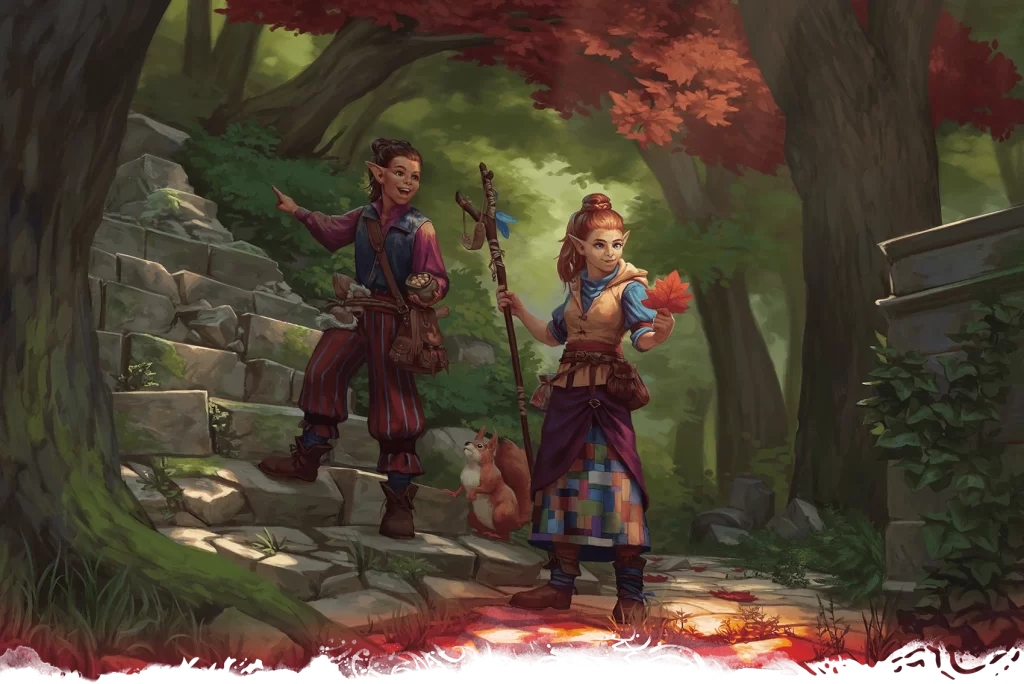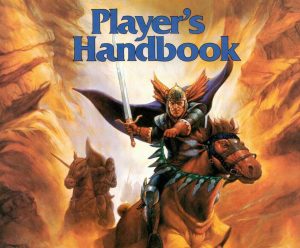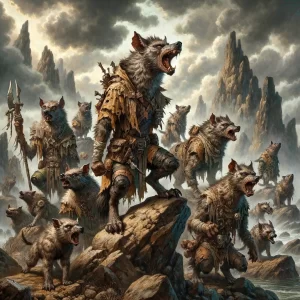
During the mythical origins of Krynn, Reorx, god of craft, indulged in an age of unfettered creation. Many peoples sprang from his divine forge, but not all among them remained as the god created them. Altered by unbridled magic, a group of gnomes were transformed and given almost supernatural curiosity and fearlessness. These were the first kender.
Originating on the world of Krynn, kender are diminutive Humanoids who look like humans with pointed ears and diverse appearances. Kender have a supernatural curiosity that drives them to adventure. Due to this inquisitiveness, many kender find themselves falling through portals to other planes and worlds.
Kender sometimes amass impressive collections of curiosities. Some might collect mundane knickknacks or relics from magical sites, while others might become professional thieves.
Origins
All kender are descended from gnomes who were magically and permanently changed by the artifact known as the Greygem, or the Greystone of Gargath. Gnomes were themselves de-scended from men who were magically altered by the deity Reorx. Kender thus came to possess most of the personality traits common to humans, though certain ones became much magnified and others disappeared.
Kender spread throughout Ansalon dur-ing the Age of Dreams, though little is said of them in official histories. The earliest known kender hero was Balif, a close friend of the elven lord Silvanos, who established the kingdom of Silvanesti. Balif fought in the First Dragonwar and established his own kingdom of kender, called Balifor. Balif died in the year 250 of the Age of Dreams.
A second kender kingdom was established in northwestern Ansalon in the year 400 of the Age of Dreams. Known as Hilo (be-cause of the mountains and low plains), this second kingdom was brought into the em-pire of Ergoth in the year 800. Following the Rose Rebellion of Vinas Solamnus (also known as the War of Ice Tears), Hilo again gained its independence and has kept it to this date.
Tragically, Balifor was destroyed during the Cataclysm. The few kender survivors wandered north and eventually established a city at Kendermore, renaming the area around it Goodlund. Kendermore is only a short distance from the remains of an old human city-state called The Ruins by the kender who explore it in droves. It is said that finding artifacts in The Ruins is easy, but leaving with them is impossible because of the local kender.
Many of the kender in Goodlund never returned to civilization, however, remaining in a state of semi-barbarism for centuries. One of these tribal kender, an unusually powerful and charismatic leader named Kronin, has begun organizing all local kender to combat the draconian and dragon armies sweeping the area. Kronin is unusu-ally antagonistic for a kender, and those few who have met him have come away shaken. Whether Kronin and his army of kender will have any effect on the current war remains to be seen.
Society
The basic unit of kender society is the immediate family (parents and children). Because kender wander so much, extended families do not truly exist. A detailed dis-cussion of kender politics, government, and society is beyond the scope of this article. Suffice to say that kender society is unique and everchanging.
Kender society can also be hard to take. Non-kender visitors rarely stay longer than a week in any major kender town, unless they have a sense of humor. "If an asylum had turned loose its inmates and a jail its thieves to run this city," wrote one traveler of Kendermore, "the end result could not have been more atrocious. I have been robbed a dozen times today, twice by constables and once by a child who could barely reach my kneecaps. I have been tormented by a hundred thousand questions, been told a million lies, and been run to exhaustion by my guide. Half the population wants to make a gynosphinx their mayor on the grounds that they have never had one before, and the other half has left in search of one. Gods take me if I ever set foot in this land again!"
Personality
Four things make a kender's personality drastically different from that of a typical human. Kender are utterly fearless, insatiably curious, unstoppably mobile and inde-pendent, and will pick up anything that is not nailed down (though kender with claw hammers will get those things as well).
The fearlessness that all kender possess gives them a strong sense of confidence. They are quite carefree or matter-of-fact about a situation, even if things look hope-less and grim. ("No sense in running away now. There's five hundred goblins sur-rounding us!") Kender react effectively to dangerous situations, fighting hard and fearlessly. They sometimes come up with some bizarre tactics which may carry the day in battle, and they don't let their fear-lessness get in the way of self-preservation - most of the time.
Kender appreciate the need for caution, but their uncontrollable curiosity gets them into trouble on adventures. They forever have to check out unexplored places and peek into dark corners. They have no desire to be the second or third persons who ever entered and left the Caverns of Unspeakable Doom; they want to be the very first. Pointing out that no one returns from the Caverns of Unspeakable Doom has no effect. In fact, describing what makes the caverns so unspeakable might even excite the kender further and make him or her determined to go to the caverns at once.
("An evil archmage and an army of ogres? Wow! Let's go see'em!") Some kender might allow their curiosity to overcome their common sense when facing unusual opponents, such as a dragon, though they eventually learn to run when running is best.
A few legends suggest that kender can actually be frightened, though only by creatures on the level of demon princes and archdevils. No one is willing to test out this theory, however, and most people believe that after the initial scare, the kender would be back to normal, pestering the monstrous prince with personal questions.
Kender are intensely curious about everything. Magic awes and fascinates them, as do any large, unusual, and dramatic creatures like chimeras, centaurs, unicorns, and, of course, dragons. Kender are drawn to beautiful things, but they may find certain things that others find disgusting to be intriguing or humorous in some way (even some gully dwarves).
Experienced adventurers quickly come to dread that most awful of kender sayings: "Oops"
Another important point is that kender need action - and they need it now. They thrive on excitement and yearn for new adventures. "I'm just along for the fun," is a common saying among wandering kender. It has been suggested that the worst torture that could be inflicted on a kender would be to lock him up and simply give him nothing new to do or look at. (Conversely, it is said that the worst torture one can visit on any non-kender would be to lock him up in a bare cell with a bored kender.) Some kender believe that evil creatures are condemned to an afterlife where they will be eternally bored.
Kender are natural extroverts and enjoy making new friends and seeing new places. The majority of them are very personable and friendly - perhaps too friendly for some people, who dislike their nosiness, their extreme talkativeness (which grows worse when they get excited), and their habit of pocketing everything that interests them. Kender also resent being given orders; they want to do what they want to do, especially if they have their minds set on doing it. Telling them to do otherwise is worse than useless, as they will complain loudly and disrespectfully, using their taunting skills if they're mad enough. The best way to handle kender, say old adventurers, is not to give them orders, but to get them to volunteer.
Handling
The kender concept of personal property and theft deserves special attention. Because many kender develop thieving talents, most people assume they are merely innocent-looking but sneaky burglars. This isn't so. The intense curiosity that kender feel feeds their desire to know how locks can be opened, how to approach people unseen and listen in on their conversations, and to reach into pockets or pouches to find interesting things to look at. Thieving comes naturally to them - so naturally that they cannot see it as thieving.
Kender do not steal for the sake of profit. First of all, they have little concept of value. Faced with a choice between a 2000 gp diamond and a huge, glittering chunk of purple glass, 90 kender out of 100 will take the glass. (The rest will take both but will get rid of the diamond first.) They pick things up out of curiosity and wander off with them. Sometimes the owner of an item leaves before the kender can give the item back, or else the kender becomes enchanted with the item and forgets to return it. If adventuring, a kender will regard anything found in an enemy stronghold as fair game for picking up, as such items are marvelous curios and might prove useful later on.






